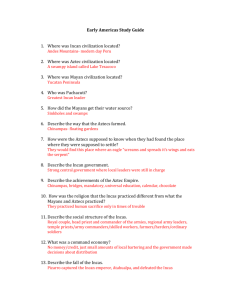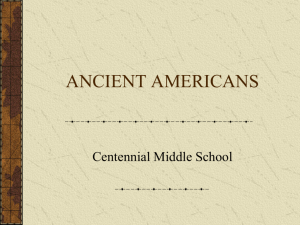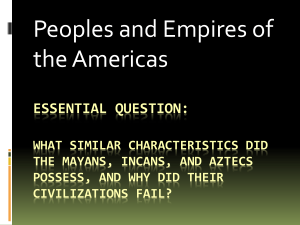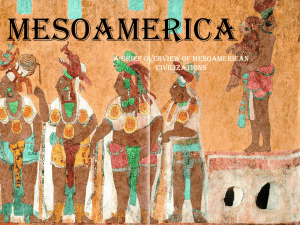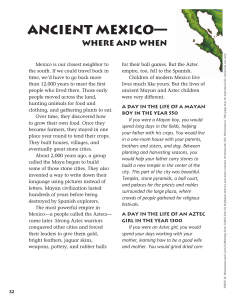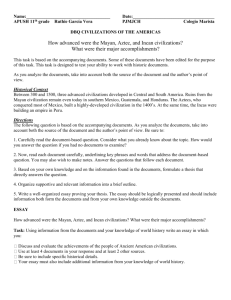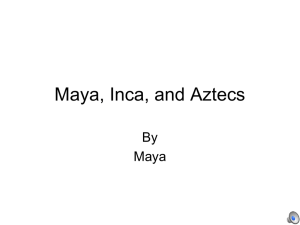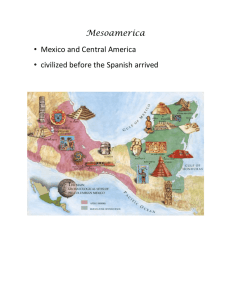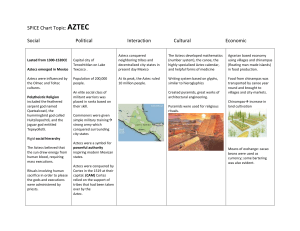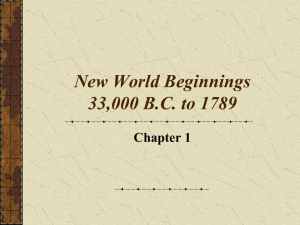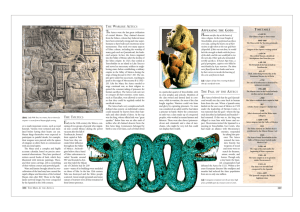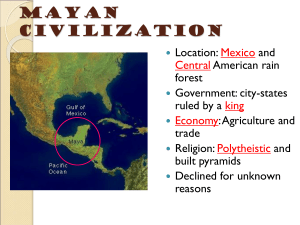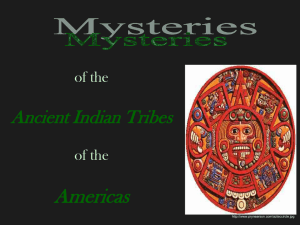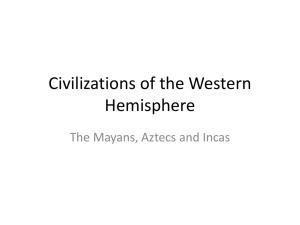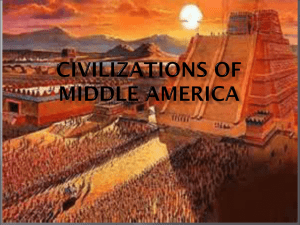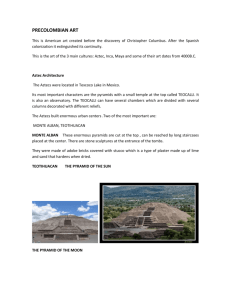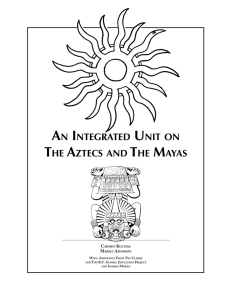LATIN AMERICA: Early Civilizations Chapt 10, Sect 1 What were the
advertisement
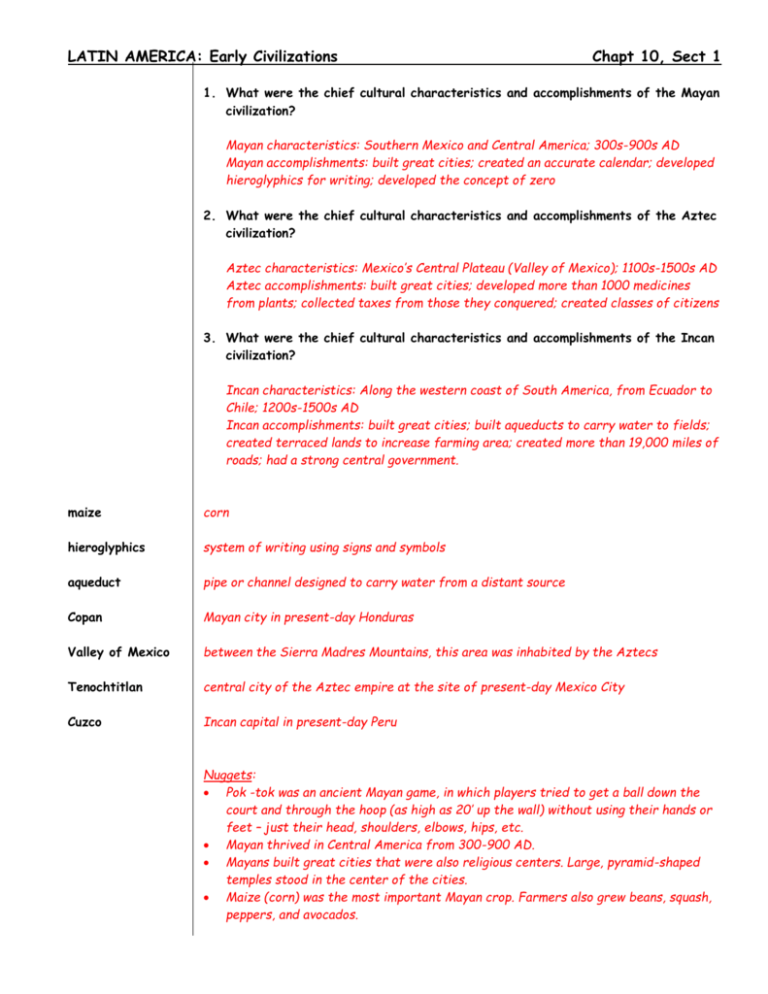
LATIN AMERICA: Early Civilizations Chapt 10, Sect 1 1. What were the chief cultural characteristics and accomplishments of the Mayan civilization? Mayan characteristics: Southern Mexico and Central America; 300s-900s AD Mayan accomplishments: built great cities; created an accurate calendar; developed hieroglyphics for writing; developed the concept of zero 2. What were the chief cultural characteristics and accomplishments of the Aztec civilization? Aztec characteristics: Mexico’s Central Plateau (Valley of Mexico); 1100s-1500s AD Aztec accomplishments: built great cities; developed more than 1000 medicines from plants; collected taxes from those they conquered; created classes of citizens 3. What were the chief cultural characteristics and accomplishments of the Incan civilization? Incan characteristics: Along the western coast of South America, from Ecuador to Chile; 1200s-1500s AD Incan accomplishments: built great cities; built aqueducts to carry water to fields; created terraced lands to increase farming area; created more than 19,000 miles of roads; had a strong central government. maize corn hieroglyphics system of writing using signs and symbols aqueduct pipe or channel designed to carry water from a distant source Copan Mayan city in present-day Honduras Valley of Mexico between the Sierra Madres Mountains, this area was inhabited by the Aztecs Tenochtitlan central city of the Aztec empire at the site of present-day Mexico City Cuzco Incan capital in present-day Peru Nuggets: Pok -tok was an ancient Mayan game, in which players tried to get a ball down the court and through the hoop (as high as 20’ up the wall) without using their hands or feet – just their head, shoulders, elbows, hips, etc. Mayan thrived in Central America from 300-900 AD. Mayans built great cities that were also religious centers. Large, pyramid-shaped temples stood in the center of the cities. Maize (corn) was the most important Mayan crop. Farmers also grew beans, squash, peppers, and avocados. LATIN AMERICA: Early Civilizations Chapt 10, Sect 1 Mayan Calendar Zero Hieroglyphics Aztec 1000+ medicines Classes of People Taxes Some in Southern Mexico Built Great Cities 19,000 Miles of Roads Aqueducts Terraced Fields Incan Conquered by Spanish Nuggets (continued) Mayan priests studied the stars and planets and created an accurate calendar to decide when to hold religious ceremonies and when farmers should plant/harvest crops. Mayans created hieroglyphics (writing system) and the concept of zero (a placeholder) About 900 AD Mayans abandoned their cities, but no one knows why. Millions still live in southern Mexico, Belize, Honduras, Guatemala, and El Salvador. Aztecs arrived in the Valley of Mexico (central plateau area) about 1100 AD. Tenochtitlan, present-day Mexico City, was built in 1325. In 1400s, Aztec warriors conquered other people in the region and forced those they conquered to pay taxes. Aztecs created classes of people: rulers; nobles and priests; warriors and traders; craftsmen; and farmers. Aztecs created more than 1000 medicines from plants. Aztec priests (astronomers) predicted eclipses and movement of planets. About 1200 AD Incas settled in Cuzco, a village in the Andes that grew to be the capitol of the Inca empire. Incas planted maize and other crops. Incan empire was more than 2500 in length and had more than 12,000,000 people Quechua, the Incan language, is still spoken by many in present-day Peru, Eucador, Bolivia, Chile, and Columbia. Incas were farmers, builders, and managers. They built: great cities; more than 19,000 miles of roads; aqueducts to water their fields; and terraced land for farming. ___________________________________________________________________________________ SUMMARY: The Mayas, Aztecs, and Incas had developed unique civilizations in Latin America before Europeans arrived.
